Located at the center of Northeast Asia, the Korean Peninsula neighbors China, Russia, and Japan. Under the World Geodetic System, it lies between 33 and 43 degrees north latitude and 124 and 132 degrees east longitude. The Peninsula (including both North and South Koreas) is 1,000 km long and 300 km wide on average, and its total land area is 222,000 km2. The total land area of South Korea (below the Military Demarcation Line) is around 100,364 km2.
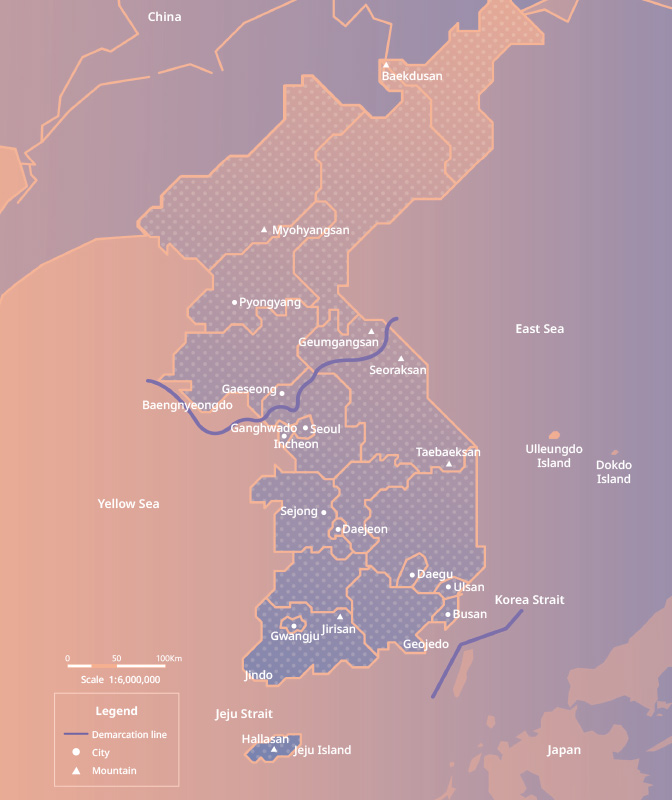
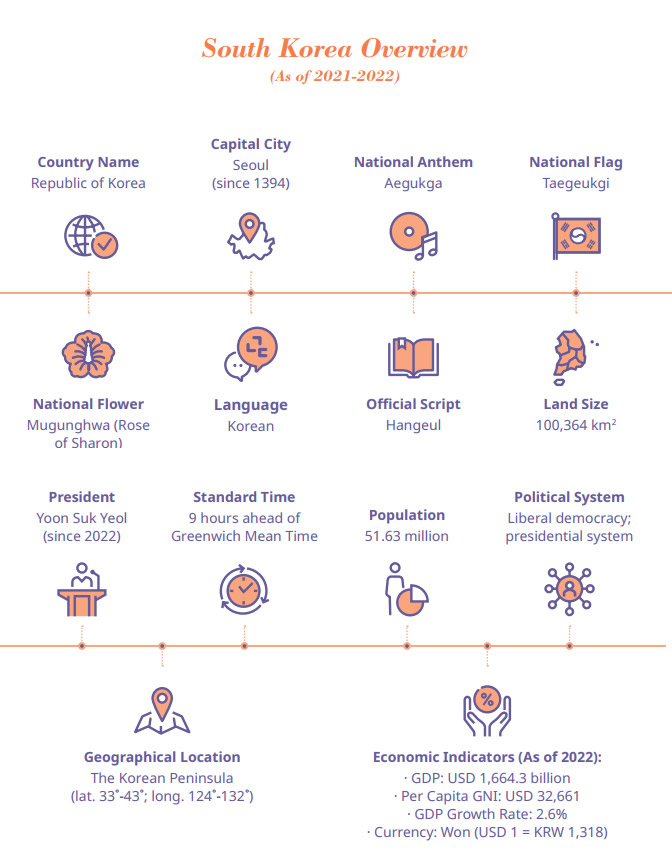
Climate
Korea has a mild climate with four distinctive seasons. The migratory anticyclones make for sunny and dry spring and autumn, whereas the country’s summer is heavily affected by the hot and humid North Pacific anticyclone. During winter, the effect of the continental anticyclone from the north keeps the country dry and cold.
The average yearly temperature in Korea ranges between 7 and 15℃. The average monthly temperature reaches its peak in August between 19.7 and 26.7℃. However, the temperature can exceed 33℃ on certain days. The country is the coldest in January, with an average monthly temperature ranging between -6.9 and 3.6℃, and snow and ice can be found anywhere across the nation. In spring and autumn, the weather is mostly sunny and pleasant with the average daytime temperature between 15 and 18℃, making the seasons perfect for outdoor activities or travels.
The annual precipitation stands at around 1,300 mm, 54% of which is concentrated in summer. In most of the years, it continues to rain for weeks (between 30 and 35 days) in July and August. This period is called jangma in Korea. Significant humidity gaps exist between seasons, reaching as high as 78 to 79% in July and August and dropping to 59 to 60% in March and April.
In recent years, there have been signs that Korea is turning into a subtropical country; subtropical squalls can often be observed during summer, farmers can now grow tropical crops such as bananas and apple mangos, and the fields suitable for previous staple crops (rice, apples, etc.) are dwindling.
Population
South Korea has the 29th largest population in the world at around 51.63 million as of 2022. However, 50.49% of the population lives in the Seoul Capital Area (SCA, mainly consisting of Seoul and Gyeonggi-do), indicating severe population gaps among regions.
Advancements in medicine and rapid economic growth increased South Koreans’ life expectancy by 21.1 years, from 62.3 in 1970 to 83.6 in 2021, which puts South Korea in third place.
The Korean government has been actively engaging in a wide range of efforts to address the country’s low birth rate and population aging.
Language and Letters
Korea has a unique language and its own writing system, “Hangeul,” which is based on Hunminjeongeum (The Proper Sounds for the Instruction of the People) invented by King Sejong (1397-1450) during the Joseon Dynasty. Hangeul is composed of 14 consonant letters and 10 vowel letters, which can be combined into new letter forms.
Hangeul is the only writing system in the world created by deliberate efforts. It features highly scientific letter-forming principles, and is capable of expressing the largest scope of sounds among the writing systems currently in existence. It is also easy to learn because letters can be formed by following simple rules.
Hangeul (Hunminjeongeum) is the only writing system inscribed on the UNESCO Memory of the World List. In addition, UNESCO also recognizes people who contributed to fighting illiteracy across the world through the UNESCO King Sejong Literacy Prize.
In recent years, Hangeul has gained global recognition for its aesthetics, and its letters are widely adopted in clothing, designs, paintings, sculpture, and other artistic disciplines.
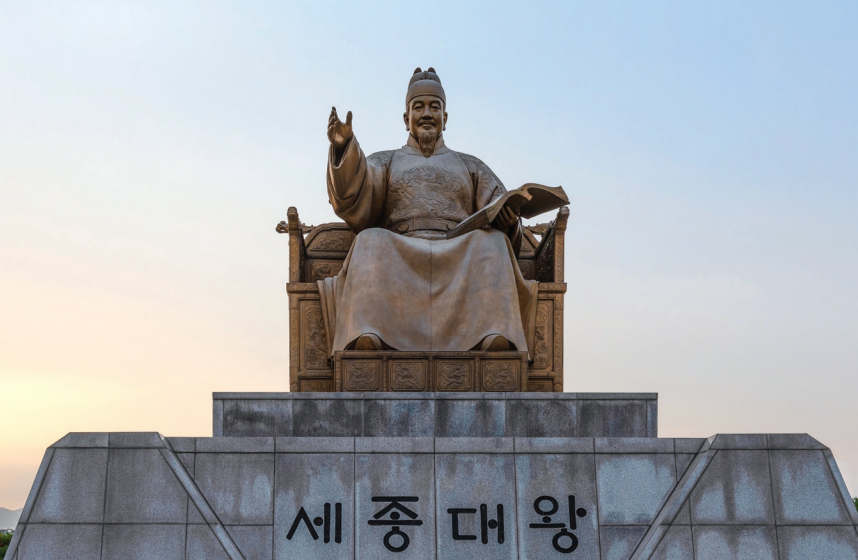
King Sejong the Great
Sejong was the fourth king of the Joseon dynasty. He made many great accomplishments in the spheres of science, economy, defense, art, and culture. One of his greatest accomplishments was the creation of Hangeul in 1443, an easy-to-learn, efficient, and scientific writing system.
He is respected as one of the country’s greatest kings among Koreans.
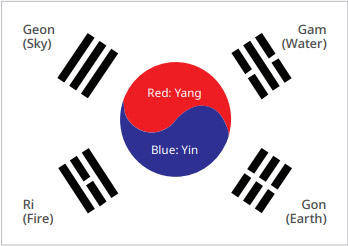
National Flag
Taegeukgi
National Flag (Taegeukgi)
The Taegeukgi was first adopted as the national flag of the Joseon Dynasty in 1883, and has been used as the national flag since the foundation of the Korean Empire was proclaimed in 1897. A taegeuk is a circle of red and blue located at the center against a white background, with four black trigrams (gwae) placed in the four corners.
The white background symbolizes brightness, purity, and peace. In contrast, the taegeuk symbolizes harmony between yin and yang (which, in the Eastern philosophy, represent the two contrasting aspects of energy that creates all beings in the universe), and the four trigrams (geon, gon, gam, and ri) represent the sky, the earth, water, and fire.
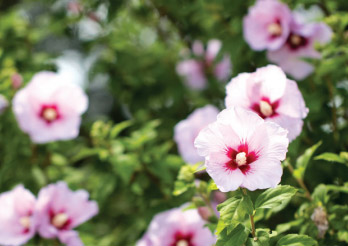
National Flower
Mugunghwa (Rose of Sharon)
National Flower (Mugunghwa)
The Mugunghwa (Rose of Sharon) is the national flower of Korea. The word “Mugunghwa” means “eternal blossom that never fades.”
National Anthem (Aegukga)
Korea’s national anthem is Aegukga (The Patriotic Song). Its lyrics were written by numerous precursors, to which Ahn Eak-tai added a melody in 1935. It was officially adopted with the establishment of the government of the Republic of Korea in 1948.
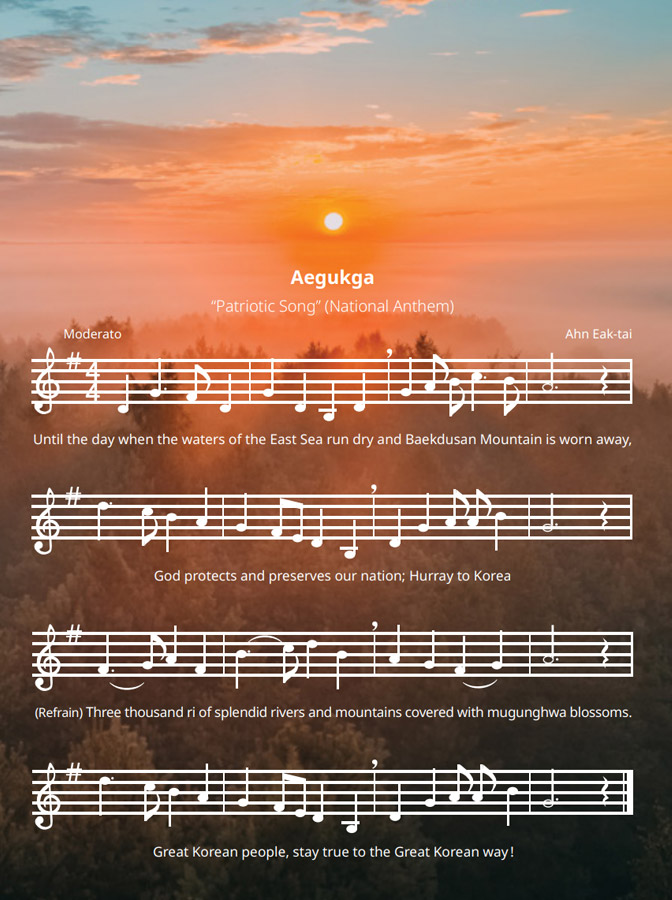
National Anthem
Aegukga
Political System
Korea is a democratic republic with a political system consisting of three distinct and independent government branches—the legislative, executive, and judicial branches—according to the principle of separation of powers. The country has adopted the Presidential system in which the President leads both the government and the administrative branch. Presidents are elected by national elections, and each serves a single five-year term.